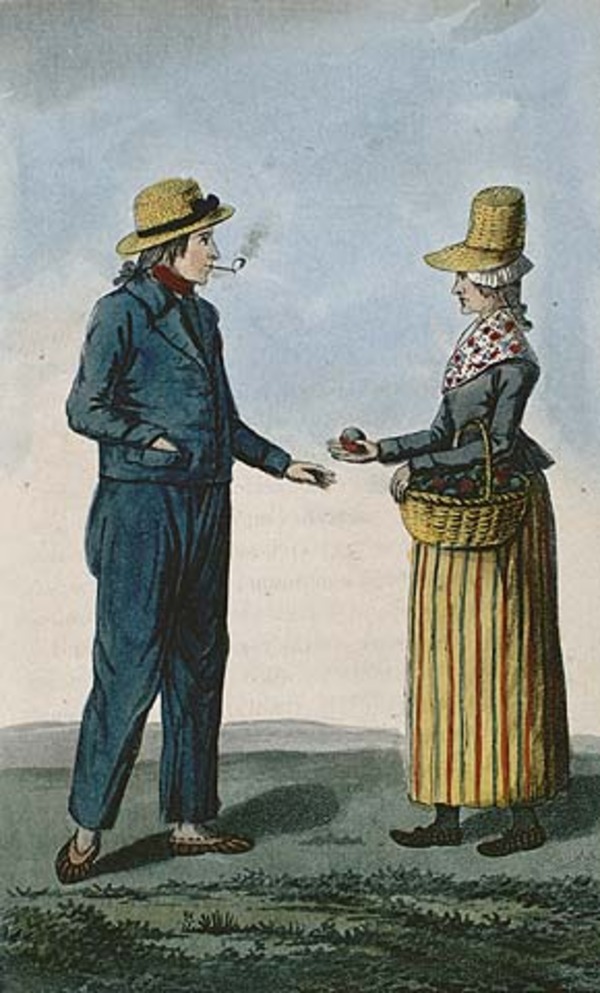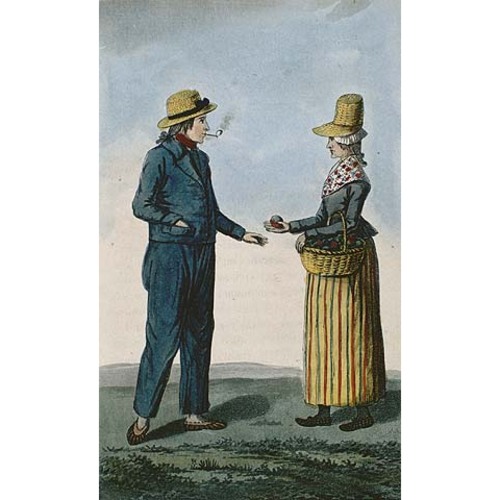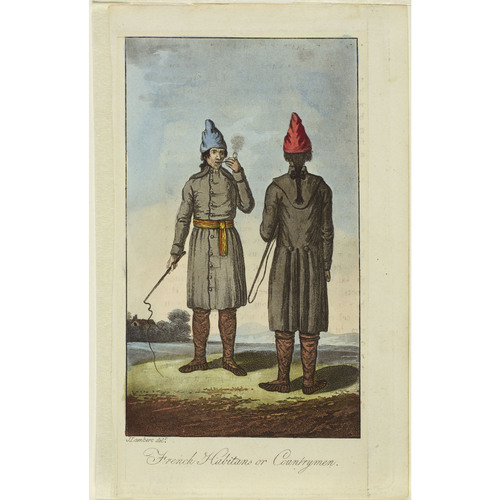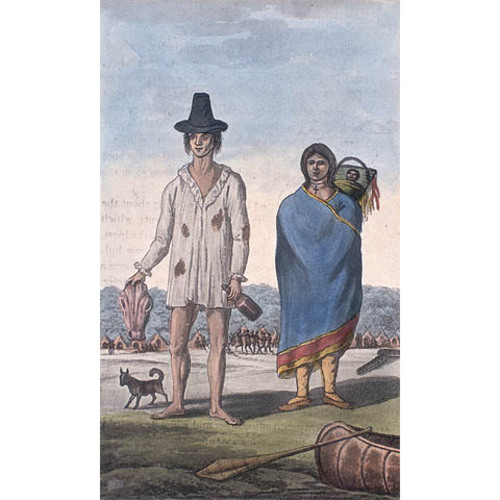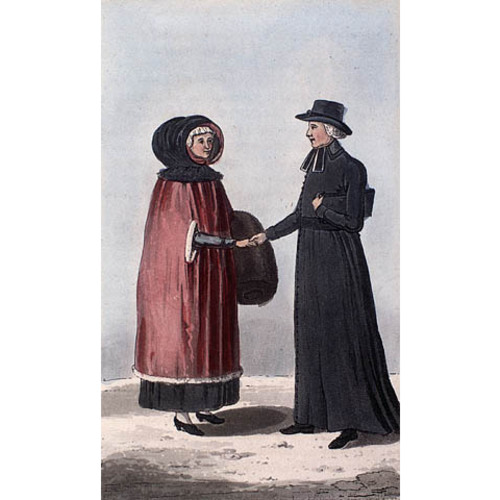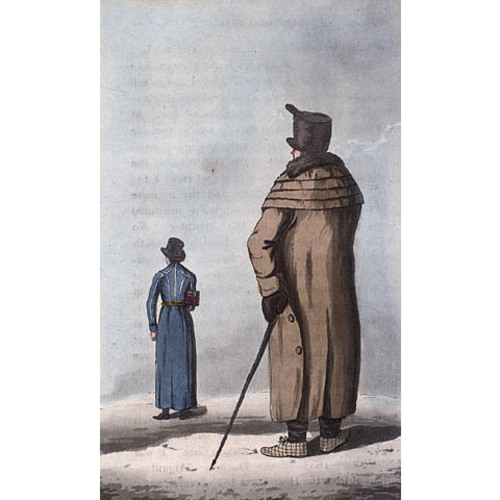LAMBERT, JOHN, traveller, author, and painter in water-colours; b. c. 1775 in England; fl. 1806–16.
John Lambert came to Lower Canada in 1806. He was accompanying his uncle, James Campbell, who had been sent by the Privy Council committee for trade in London to promote the growing of hemp in the colony. It does not seem, however, that Lambert was in any way engaged in this project, which failed around 1810. In 1806, well before that outcome, he set off on travels about the colony and in various American states. He may already have been been thinking of writing an account of his voyage. One thing is certain: it was as a perspicacious observer with a critical and extremely sharp eye that he carried out his tour, accumulating facts and anecdotes of all kinds.
Lambert remained in Lower Canada in 1806 and 1807, visiting Quebec, Montreal, and the towns and villages in between. In each place he seems to have associated with the influential people and to have been welcomed warmly and unreservedly in British and Canadian, Catholic and Protestant homes. Later he toured the United States, from the state of New York to South Carolina, in the same fashion.
Lambert returned to Quebec in 1809 and left again for London almost immediately. The following year he brought out in three volumes his Travels through Lower Canada, and the United States of North America, in the years 1806, 1807, and 1808; its great success led him to prepare a second edition in two volumes in 1813, a third one the following year, and a fourth in 1816. He illustrated the work himself with rather restrained and naïve water-colours depicting some of the places visited, objects of everyday use, and the clothing worn by women, priests, soldiers, seminary students, and Indians. In 1811 Lambert also brought out, with a long and laudatory introduction on American life, a British edition of a work he considered a model of American literature, Washington Irving’s essays Salmagundi; or, the whim-whams and opinions of Launcelot Langstaff, esq., and others . . . .
Lambert claimed that he published his Travels, which professed to offer a description of the social and economic situation of Lower Canada, because the colony’s rapid progress had made earlier travel accounts obsolete; the last one, Isaac Weld*’s Travels through the states of North America, and the provinces of Upper and Lower Canada, during the years 1795, 1796 and 1797, had come out in London in 1799. In his book Lambert displayed no class or party interest. As far as possible he tried to paint a fair and realistic picture of Lower Canada, although on occasion he was unable to conceal his aversion for still-visible signs of the influence of the French régime and for the Roman Catholic clergy; he considered the clergy useful, to be sure, because of their social vocation, but also thought they fostered ossification and backwardness amongst the Catholics.
Far from presenting a chronological account of his voyage, Lambert arranged his notes to depict in each of his chapters a different aspect of Lower Canada: geography, climate, geology, botany, and zoology. He studied both towns and countryside, estimated the size of the population, and compiled a mass of data, backed with tables, on such facets of the economy as agriculture, industry, retail trade, the fur trade, exports, imports, money, and many other elements. Lambert also paid attention to social circumstances. He described the Indians’ way of life and their decline, divided the population of the towns and countryside into social classes, and with numerous anecdotes recounted the ways and customs of the habitants and the town-dwellers. He depicted, sometimes ironically but never dishonestly or antagonistically, various groups such as priests, nuns, and women; lie considered the latter to be better educated than their husbands and to have great influence on them. He also tried to fathom the judicial system and French law, explain seigneurial tenure, and assess the church’s hold on the Canadians.
Lambert proved just as meticulous in his description of American society; he compared it favourably with Lower Canadian society in virtually all areas: roads, farms, towns, trade, education, art, wealth – and scandals. His analysis also showed the glaring difference that already existed between the anglophones in Lower Canada and the Americans, a generation after the states had gained independence.
Biographical information on John Lambert is extremely fragmentary. And yet his short stay in Canada turned out to be of real importance, for the writings that resulted from it have been widely read and used by historians, story-tellers, and novelists. The author’s desire to be objective is so evident throughout the work that many have been convinced of the merit of the account and the soundness of its arguments. There is, however, no doubt that Lambert was above all faithful to his period and his origins.
[John Lambert’s Travels through Lower Canada, and the United States of North America, in the years 1806, 1807, and 1808, to which are added, biographical notices and anecdotes of some of the leading characters in the United States; and of those who have, at various periods, borne a conspicuous part in the politics of that country was published in three volumes in London in 1810; it reappeared under slightly different titles in two volumes in 1813, 1814, and 1816. Despite its success and the wide use made of it by francophone historians, Lambert’s Travels has never been translated. However, extracts in French have appeared in several articles, notably “Du voyage de J. Lambert en Canada (1810),” La Bibliothèque canadienne (Montréal), 3 (1826): 130–32; “État de la littérature canadienne en 1809,” 7 (1828): 57–60; Ægidius Fauteux, “La romanesque mais peu véridique histoire de Mlle d’Artigny,” BRH, 41 (1935): 167–71. j.r.]
C. P. De Volpi, Québec, a pictorial record . . . 1608–1875, trans. Jules Bazin (n.p., 1971). DNB. Hare et Wallot, Les imprimés dans le Bas-Canada, 259–62. J. R. Harper, Early painters and engravers in Canada ([Toronto], 1970). Norah Story, The Oxford companion to Canadian history and literature (Toronto and London, 1967). Tremaine, Biblio. of Canadian imprints. Histoire littéraire du Canada, littérature canadienne de langue anglaise, ed. C. F. Klinck et al., trans. Maurice Lebel (Québec, 1970), 122, 163, 222. Sulte, Mélanges hist. (Malchelosse), 7: 116–18.
Cite This Article
Jacqueline Roy, “LAMBERT, JOHN,” in Dictionary of Canadian Biography, vol. 5, University of Toronto/Université Laval, 2003–, accessed January 23, 2025, https://www.biographi.ca/en/bio/lambert_john_5E.html.
The citation above shows the format for footnotes and endnotes according to the Chicago manual of style (16th edition). Information to be used in other citation formats:
| Permalink: | https://www.biographi.ca/en/bio/lambert_john_5E.html |
| Author of Article: | Jacqueline Roy |
| Title of Article: | LAMBERT, JOHN |
| Publication Name: | Dictionary of Canadian Biography, vol. 5 |
| Publisher: | University of Toronto/Université Laval |
| Year of revision: | 1983 |
| Access Date: | January 23, 2025 |


